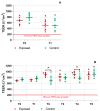The Biological Effects of Complete Gasoline Engine Emissions Exposure in a 3D Human Airway Model (MucilAirTM) and in Human Bronchial Epithelial Cells (BEAS-2B)
- PMID: 31739528
- PMCID: PMC6888625
- DOI: 10.3390/ijms20225710
The Biological Effects of Complete Gasoline Engine Emissions Exposure in a 3D Human Airway Model (MucilAirTM) and in Human Bronchial Epithelial Cells (BEAS-2B)
Abstract
The biological effects induced by complete engine emissions in a 3D model of the human airway (MucilAirTM) and in human bronchial epithelial cells (BEAS-2B) grown at the air-liquid interface were compared. The cells were exposed for one or five days to emissions generated by a Euro 5 direct injection spark ignition engine. The general condition of the cells was assessed by the measurement of transepithelial electrical resistance and mucin production. The cytotoxic effects were evaluated by adenylate kinase (AK) and lactate dehydrogenase (LDH) activity. Phosphorylation of histone H2AX was used to detect double-stranded DNA breaks. The expression of the selected 370 relevant genes was analyzed using next-generation sequencing. The exposure had minimal effects on integrity and AK leakage in both cell models. LDH activity and mucin production in BEAS-2B cells significantly increased after longer exposures; DNA breaks were also detected. The exposure affected CYP1A1 and HSPA5 expression in MucilAirTM. There were no effects of this kind observed in BEAS-2B cells; in this system gene expression was rather affected by the time of treatment. The type of cell model was the most important factor modulating gene expression. In summary, the biological effects of complete emissions exposure were weak. In the specific conditions used in this study, the effects observed in BEAS-2B cells were induced by the exposure protocol rather than by emissions and thus this cell line seems to be less suitable for analyses of longer treatment than the 3D model.
Keywords: 3D models; cell monocultures; complete engine emissions; gene expression.
Conflict of interest statement
The authors declare no conflict of interest.
Figures









References
-
- International Agency for Research on Cancer (IARC) Diesel and Gasoline Engine Exhausts and Some Nitroarenes. Volume 105 IARC Publications; Lyon, France: 2013. IARC Monographs on the Evaluation of the Carcinogenic Risk of Chemicals to Humans. - PubMed
MeSH terms
Substances
Grants and funding
LinkOut - more resources
Full Text Sources
Miscellaneous

